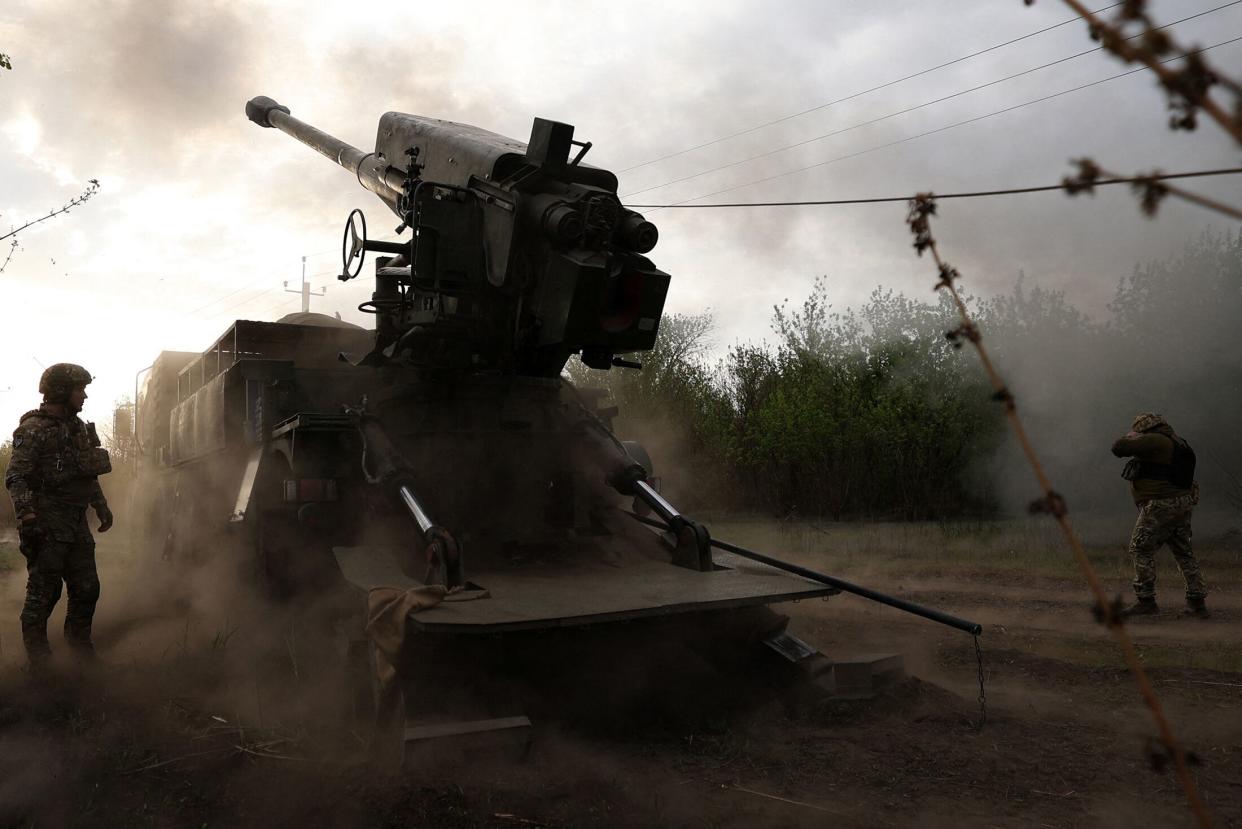US Aid Gives Kyiv Respite But Battlefield Shift Remains Far Off

(Bloomberg) -- US approval of more than $60 billion in aid throws a lifeline to Ukraine’s beleaguered military, though it’s unlikely to turn the tide in the war on its own.
Most Read from Bloomberg
Trump Has Only $6.8 Million for Legal Fees With Trial Underway
TikTok to Remove Executive Tasked With Fending Off US Claims
Ray Dalio’s Famous Trade Is Sputtering and Investors Are Bailing
Stocks Climb as US Earnings Kick Into High Gear: Markets Wrap
US Dollar’s Extended Reign Delivers Stark Wake-Up Call for Markets
Much will depend on how quickly US assistance can get to the front line after the House of Representatives approved the military and economic assistance on Saturday. As the package was stalled for six months in Congress, Kyiv’s military has grappled with an ever-more acute shortage of ammunition and manpower, while Kremlin forces press their advantage.
The aid offers a respite to Ukraine’s military and will help it slow the Kremlin’s advances, conduct an “effective defense” and minimize losses, according to Mykola Bielieskov, research fellow at the National Institute for Strategic Studies in Kyiv. But more aid is needed to go further, he said, a difficult prospect in the US with Republican resistance in Congress.
“The question is whether there will be aid and in what volume in 2025 and beyond — as Putin’s strategy is to wait it out,” he said.
Russia has escalated its barrages of missile and drone attacks as the war crossed over into a third year, decimating swathes of Ukraine’s power-generating infrastructure and destroying residential buildings in city centers. President Volodymyr Zelenskiy said the US legislation, which should clear further hurdles this week, will bolster his military.
“We did lose the initiative,” Zelenskiy told NBC’s “Meet the Press” on Sunday. “Now we have all the chance to stabilize the situation and to overtake the initiative.”
The legislation is set to make it to President Joe Biden’s desk this week after the Senate takes up the package as soon as Tuesday. The US Defense Department could get weapons moving to Ukraine “very quickly” once the aid flows, Pentagon spokesman Pat Ryder said last week.
Oksana Markarova, Ukraine’s ambassador to the US, said Friday that delivery logistics have been in the works all along.
“The Pentagon and our Defense Ministry didn’t stop working daily together at finding weapons, identifying them and such packages are being prepared,” Markarova told Ukrainian television.
Read more: Zelenskiy Says US Aid Gives Ukraine Means to Retake Initiative
Some of the equipment, which will likely include longer-range Army Tactical Missile Systems, or ATACMS, could be on the way by the end of the week, Democrat Mark Warner, chairman of the Senate Intelligence Committee, said on CBS’s “Face the Nation.”
Elsewhere, Germany will keep pressing European allies this week, including France and Italy, to supply air defense systems and components for Ukraine, according to people familiar with the matter. Berlin, which has also been urging NATO countries to figure out what they can send, has committed to providing Ukraine with a third Patriot battery as well as other systems and ammunition.
Painful shortages in weapons and manpower along the 1,200-kilometer (930-mile) front, along with a dire need for more air defense systems, have pushed Ukraine’s fighting forces close to a breaking point, raising the risk of a Russian breakthrough. Moscow has also escalated its bombardment of Kharkiv, Ukraine’s second-largest city, in what Ukrainian and Western officials see as a bid to force an evacuation of the city, less than an hour’s drive from the Russian border.
‘Seriously Damaged’
Even if US materiel moves quickly, transport logistics will likely mean the aid “will not begin to affect the situation on the front line for several weeks,” according to analysts at the US-based Institute for the Study of War.
“The frontline situation will therefore likely continue to deteriorate in that time, particularly if Russian forces increase their attacks to take advantage of the limited window before the arrival of new US aid,” the analysts said.
Russian President Vladimir Putin’s forces, seeking to benefit from the widening gap in ammunition supplies, have ratcheted up their firepower all along the front, and made marginal gains since capturing the eastern city of Avdiivka in February.
Kremlin troops are focusing on strategically key spots, such as the town of Chasiv Yar, west of Bakhmut in the Donetsk region, as they currently out-gun Ukraine’s army in artillery on the battlefield 10-to-one.
“The Ukrainians have been seriously damaged and their armed forces are weaker than they would have been otherwise,” Phillips O’Brien, a professor of strategic studies at the University of St. Andrews in Scotland, wrote after the US House vote. “At least now, however, with a major infusion of US aid, the Ukrainians should be able to stabilize the line.”
In contrast with a year ago, when spring weather brought with it hopes for a successful counteroffensive by well-armed Ukrainian forces, the failure of that campaign and dwindling assistance from allies in the months since have darkened the public mood.
Zelenskiy signaled that there is no time to lose after the package is disbursed, with Ukrainian and US officials in continuous contact to ensure the deliveries are made.
“The time between political decision and real hitting of the enemy on the front line must be as short as possible,” the Ukrainian leader said in his regular address to the nation on Sunday. “Now, every day matters.”
--With assistance from Volodymyr Verbianyi, Olesia Safronova, Jennifer Jacobs and Alberto Nardelli.
Most Read from Bloomberg Businessweek
How a Massive Hack of Psychotherapy Records Revealed a Nation’s Secrets
What Really Happens When You Trade In an iPhone at the Apple Store
Rents Are the Fed’s ‘Biggest Stumbling Block’ in Taming US Inflation
©2024 Bloomberg L.P.


